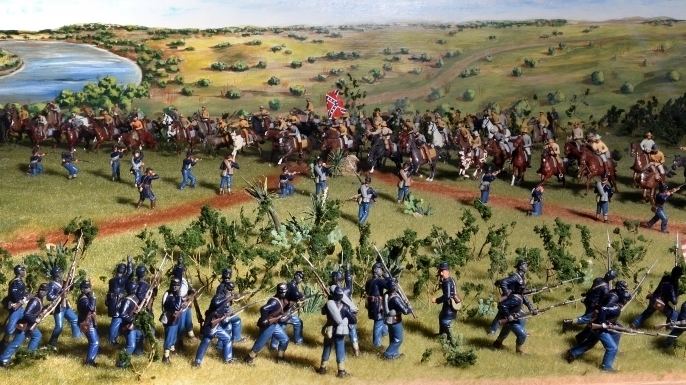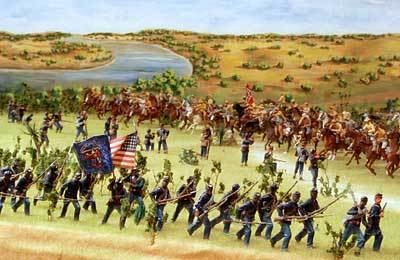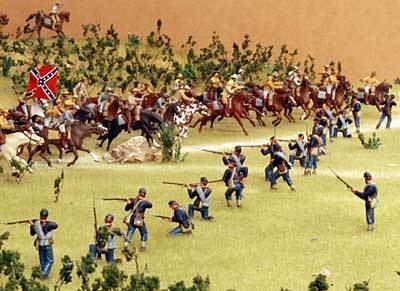Theodore H. Barrett 4 killed12 wounded101 captured 5–6 wounded3 captured | 500 300 Dates 12 May 1865 – 13 May 1865 | |
 | ||
Similar American Civil War, Second Battle of Sabine P, Battle of Galveston, Battle of Appomattox Court Ho, Battle of Brownsville | ||
The Battle of Palmito Ranch, also known as the Battle of Palmito Hill, is generally recognized as the final battle of the American Civil War. It was fought May 12 and 13, 1865, on the banks of the Rio Grande east of Brownsville, Texas and a few miles from the seaport of Los Brazos de Santiago, more than a month after Robert E. Lee had surrendered to Ulysses S. Grant in the Eastern Theater. Though the Battle of Appomattox Court House is identified as the last major battle of the war, Palmito Ranch was the last engagement between organized forces of the Union Army and Confederate States Army involving casualties.
Contents
- Battle of palmito ranch may 13 1865 american civil war
- Background
- Battle
- Aftermath
- Battlefield
- References

Union and Confederate forces in southern Texas had been observing an unofficial truce, but Union Colonel Theodore H. Barrett ordered an attack on a Confederate camp near Fort Brown for unknown reasons; anecdotes suggest he wanted to see combat before the war ended. The Union attackers captured a few prisoners, but the following day the attack was repulsed near Palmito Ranch by Colonel John Salmon Ford, and the battle became a Confederate victory. Union forces were surprised by Confederate artillery, said to have been supplied by the French Army occupying the nearby Mexican town of Matamoros. Rumors also persist that Confederates were assisted by a steam-powered French gun boat patrolling the Rio Grande.
Casualty estimates are not dependable, but Union Private John J. Williams of the 34th Indiana Infantry Regiment is believed to have been the last man killed in combat during the war.

Battle of palmito ranch may 13 1865 american civil war
Background

After July 27, 1864, the Union Army withdrew most of the 6,500 troops deployed to the lower Rio Grande Valley, including Brownsville, which they had occupied since November 2, 1863. The Confederates were determined to protect their remaining ports, which were essential for cotton sales to Europe, and the importation of supplies. The Mexicans across the border tended to side with the Confederates because of the lucrative smuggling trade. Beginning in early 1865, the rival armies in south Texas honored a gentlemen's agreement, as they saw no point in further hostilities between them.

Union Major General Lew Wallace proposed a negotiated end of hostilities in Texas to Confederate Brigadier General James E. Slaughter and met with Slaughter and his subordinate Colonel Ford at Port Isabel on March 11–12, 1865. Despite Slaughter's and Ford's agreement that combat would prove tragic, Slaughter's superior, Confederate Maj. Gen. John G. Walker, rejected the ceasefire in a scathing exchange of letters with Wallace. Despite this, both sides honored a tacit agreement not to advance on the other without prior written notice.

A brigade of 1,900 Union troops commanded by Col. Robert B. Jones of the 34th Indiana Veteran Volunteer Infantry were on blockade duty at the Port of Brazos Santiago at the mouth of the present-day ship channel of the Port of Brownsville. The 400-man 34th Indiana was an experienced regiment that had served in the Vicksburg Campaign and was then reorganized in December 1863 as a "Veteran" regiment composed entirely of veterans from several other regiments whose original enlistments had expired. The 34th Indiana deployed to Los Brazos de Santiago on December 22, 1864, replacing the 91st Illinois Volunteer Infantry, which returned to New Orleans. The brigade also included the 87th and 62nd United States Colored Infantry Regiments ("United States Colored Troops", or U.S.C.T.) which had a combined strength of about 1,100. Shortly after Gen. Walker rejected the armistice proposal, Col. Jones resigned from the army to return to Indiana. He was replaced in the regiment by Lt. Col. Robert G. Morrison and at Los Brazos de Santiago by Colonel Theodore H. Barrett, commander of the 62nd U.S.C.T.
The 30-year-old Barrett had been an army officer since 1862, but he had yet to see combat. Anxious for higher rank, he volunteered for the newly raised "colored" regiments and was appointed colonel of the 1st Missouri Colored Infantry in 1863. In March 1864, the regiment became the 62nd U.S.C.T. Barrett contracted malaria in Louisiana that summer, and while he was on convalescent leave, the 62nd was posted to Brazos Santiago. He joined it there in February 1865.
Why this final battle at Palmito Ranch even took place is still debated. Lee had surrendered to Grant in Appomattox Court House, Virginia on April 9, triggering a series of formal surrenders in other places throughout the country. Soon after the battle, Barrett's detractors claimed he desired "a little battlefield glory before the war ended altogether." Others have suggested that Barrett needed horses for the 300 dismounted cavalrymen in his brigade and decided to take them from his enemy. Louis J. Schuler, in his 1960 pamphlet The last battle in the War Between the States, May 13, 1865: Confederate Force of 300 defeats 1,700 Federals near Brownsville, Texas, asserts that Brig. Gen. Egbert B. Brown of the U.S. Volunteers had ordered the expedition to seize as contraband 2,000 bales of cotton stored in Brownsville and sell them for his own profit. However, this is impossible as Brown was not appointed to command at Brazos Santiago until later in May.
Battle
Lieutenant Colonel David Branson wanted to attack the Confederate encampments commanded by Ford at White and Palmito Ranches near Fort Brown outside Brownsville. Branson's Union forces consisted of 250 men of the 62nd U.S.C.T. in eight companies and two companies of the (U.S.) 2nd Texas Cavalry Battalion. The 300-man 2nd Texas, like the earlier-formed 1st Texas Cavalry Regiment, was composed largely of Texans of Mexican origin who remained loyal to the United States. They moved from Brazos Santiago to the mainland. At first Branson's expedition was successful, capturing three prisoners and some supplies, although it failed to achieve the desired surprise. During the afternoon, Confederate forces under Captain William N. Robinson counterattacked with less than 100 cavalry, driving Branson back to White's Ranch, where the fighting stopped for the night. Both sides sent for reinforcements; Ford arrived with six French guns and the remainder of his cavalry force (for a total of 300 men), while Barrett came with 200 troops of the 34th Indiana in nine understrength companies.
The next day, Barrett started advancing westward, passing a half-mile to the west of Palmito Ranch, with skirmishers from the 34th Indiana deployed in advance. Ford attacked Barrett's force as it was skirmishing with an advance Confederate force along the Rio Grande about 4 p.m. He sent a couple of companies with artillery to attack the Union right flank and the remainder of his force into a frontal attack. After some confusion and fierce fighting, the Union forces retreated towards Boca Chica. Barrett attempted to form a rearguard, but Confederate artillery prevented him from rallying a force sufficient to do so. During the retreat, which lasted until 14 May, 50 members of the 34th Indiana's rearguard company, 30 stragglers, and 20 of the dismounted cavalry were surrounded in a bend of the Rio Grande and captured. The battle is recorded as a Confederate victory.
Fighting in the battle involved Caucasian, African-American, Hispanic, and Native American troops. Reports of shots from the Mexican side, the sounding of a warning to the Confederates of the Union approach, the crossing of Imperial cavalry into Texas, and the participation by several among Ford's troops are unverified, despite many witnesses reporting shooting from the Mexican shore.
In Barrett's official report of August 10, 1865, he reported 115 Union casualties: one killed, nine wounded, and 105 captured. Confederate casualties were reported as five or six wounded, with none killed. Historian and Ford biographer Stephen B. Oates, however, concludes that Union deaths were much higher, probably around 30, many of whom drowned in the Rio Grande or were attacked by French border guards on the Mexican side. He likewise estimated Confederate casualties at approximately the same number. Using court-martial testimony and post returns from Brazos Santiago, historian Jerry D. Thompson of Texas A&M International University determined that:
Private John J. Williams of the 34th Indiana was the last fatality during the Battle at Palmito Ranch, likely making him the final combat death of the entire war, since historians generally agree that this was the final battle.
Aftermath
Confederate General Edmund Kirby Smith officially surrendered all Confederate forces in the Trans-Mississippi Department, except those under the command of Brigadier General Chief Stand Watie, on June 2, 1865. Stand Watie, of the 1st Cherokee Mounted Rifles, became the last Confederate general to surrender his forces on June 23, 1865, in Doaksville, Indian Territory. On that same day, President Andrew Johnson ended the Union blockade of the Southern states.
Many senior Confederate commanders in Texas (including Smith, Walker, Slaughter, and Ford) and many troops with their equipment fled across the border to Mexico, possibly to ally with French Imperial forces or with Mexican forces under deposed President Benito Juárez.
The Military Division of the Southwest (after June 27 the Division of the Gulf), commanded by Maj. Gen. Phillip H. Sheridan, occupied Texas between June and August. Consisting of the IV Corps, XIII Corps, the African-American XXV Corps, and two 4,000-man cavalry divisions commanded by Brig. Gen. Wesley Merritt and Maj. Gen. George A. Custer, it aggregated a 50,000-man force on the Gulf Coast and along the Rio Grande to pressure the French intervention in Mexico and garrison the Reconstruction Department of Texas.
In July 1865, Barrett preferred charges of disobedience of orders, neglect of duty, abandoning his colors, and conduct prejudicial to good order and military discipline against Morrison for actions in the battle, resulting in the latter's court martial. Confederate Col. Ford, who had returned from Mexico at the request of Union Gen. Frederick Steele to act as parole commissioner for disbanding Confederate forces, appeared as a defense witness and assisted in absolving Morrison of responsibility for the defeat.
The history of the battle is also significant for providing accounts of the roles of Hispanic Confederate veterans and of the treatment of black prisoners-of-war in South Texas. There were Hispanic Confederate veterans at Fort Brown in Brownsville and on the field of Palmito Ranch. Col. Santos Benavides, who was the highest ranking Hispanic in either army, led between 100 and 150 Hispanic soldiers in the Brownsville Campaign in May 1865.
Some of the Sixty-Second Colored Regiment were also taken. They had been led to believe that if captured they would either be shot or returned to slavery. They were agreeably surprised when they were paroled and permitted to depart with the white prisoners. Several of the prisoners were from Austin and vicinity. They were assured they would be treated as prisoners of war. There was no disposition to visit upon them a mean spirit of revenge.
When Colonel Ford surrendered his command following the campaign of Palmito Ranch he urged his men to honor their paroles. He insisted that "The negro had a right to vote."
On April 2, 1866, President Johnson declared the insurrection at an end, except in Texas, because of a technicality concerning incomplete formation of a new state government. He declared the insurrection at an end in Texas and throughout the United States on August 20, 1866.
Battlefield
Today, the Palmito Ranch Battlefield preserves the location of the last battle of the American Civil War. The area has remained relatively unchanged, with the marshy, windswept prairies almost the same as they were in 1865. Over 5,400 acres (2,200 ha) are protected at the site, which is included in the National Register of Historic Places. The only indication that anything happened here, however, is a marker on the "Boca Chica Highway" (Texas State Highway 4) near where Palmito Ranch originally stood.
